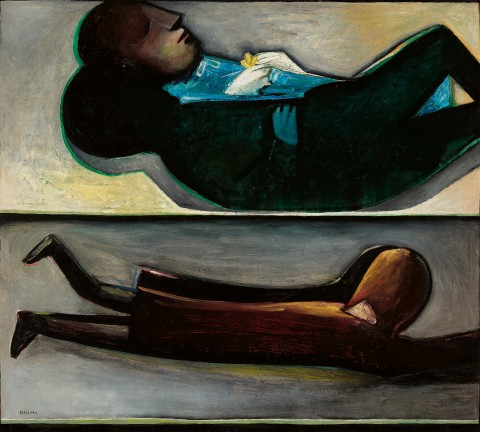DOUBLE IMAGE, 1961
CHARLES BLACKMAN
oil on composition board
137.0 x 152.5 cm
signed lower left: BLACKMAN
Private collection, Perth
Private collection, Melbourne
Deutscher~Menzies, Melbourne, 22 November 1998, lot 283
Private collection, Melbourne
Probably: Paintings and Drawings: Charles Blackman, The Matthiesen Gallery, London, 3 – 25 November 1961
‘…Part of their essential character springs from the interpretation, marvellously developed and sustained, between the tenderness and grace of the personages contained in the paintings and the fiercely implacably controlled means taken to give these personages life and eloquence within the terms of painting itself…’1
At the time of unveiling his seminal solo show at Mathiesen Gallery in London in November 1961 (in which Double Image, 1961 was most likely included), Charles Blackman’s star was in the ascendent. In 1958, one of his Alice paintings had been acquired by the Musée d’Art Moderne in Paris (a remarkable feat for any Australian artist), and in June 1960, his solo exhibition at the Johnstone Gallery had completely sold out, realising approximately £4,500 pounds and enabling the Blackmans to buy a house in St Lucia, Queensland. Two months later he was awarded the prestigious Helena Rubinstein Travelling Art Scholarship for his celebrated Suites I – IV (now housed in the collections of the state galleries of New South Wales, Queensland and Western Australia), and by the following February, he and his family had relocated to London where they would remain for the next five years. In June 1961, three of his paintings were featured in the groundbreaking Recent Australian Painting exhibition at the Whitechapel Art Gallery in London, alongside major works by Boyd, Nolan, Tucker and Whiteley, and later that year, he was selected, together with Whiteley and Lawrence Daws, to represent Australia at the progressive Biennale des Jeunes organsised by the Musée d’Art Moderne, Paris.
An impressive achievement both in scale and conceptual breadth, Double Image comprises one of a select few works created during this pivotal period in Blackman’s oeuvre when, stimulated by the dynamic European art scene, he was at the height of his artistic powers and critical success. As one London newspaper critic observed of his representation at the Whitechapel show, ‘The most moving – and the discovery of the exhibition – are the three remarkable paintings by Charles Blackman… It is fanciful to see in this painting not only a new and original talent but a sign that Australian painting is at last moving away from its obsession with the outback?’2 Meanwhile, English art critic Bryan Robertson, an early champion of the young Antipodean’s work, was so impressed that he offered to arrange the subsequent solo exhibition for Blackman at the Mathiesen Gallery, writing in the Preface to that catalogue: ‘These are some of the strongest, most urgent and forceful paintings by a young artist that I have seen in the past ten years.’3
Possibly with the present work in mind, Robertson continued: ‘…Perhaps the dense blacks refer to the discrepancy between innocence and experience, making a further parallel with the tension between the idea and its projection, its shape and surface. We are given a curious impression, often of a double image, positive and negative, as well as of the space between people…’4 As reiterated by art historian David Hansen, a dominant feature and recurrent motif of Blackman’s art, is precisely that of the ‘double image’ encapsulated so powerfully here. From the head-spinning Star Gazer, 1955 to the Through the Looking Glass and Janus-faced Alice with Teapot Crown, 1956; the matching arm gestures of Waiting, 1961 or the dual figures of the iconic Dreaming in the Street, 1960 (National Gallery of Victoria) where one is depicted in bright light and full colour, and her companion reduced to a dark, anonymous silhouette.5 Separated into two voyeuristic vignettes akin to a split-screen ‘suite’, it is difficult to know whether Double Image accordingly represents two separate people or one and her shadow (psychological or emotional, rather than physical). Imbued with an aching sense of isolation and betraying an almost existential quality, indeed, it is perhaps not a coincidence that Blackman was reading Danish philosopher Soren Kierkegaard’s Either/Or (1843) at the time – a theory of human existence characterised by the enduring opposition between the essentially hedonistic-aesthetic heart and the critical-ethical mind.6 Such would also seem to accord with Robertson’s contemporary interpretation of the duality inherent in these poignant ‘double Image’ works, ‘…the paintings show their own synthesis, supercharged between romantic vision and classical compression of form.’7
1. Robertson, B., ‘Preface’, Charles Blackman: Paintings and Drawings, The Mathiesen Gallery, London, 1961, n.p.
2. Pringle, J.D., ‘The Australian Painters’ in Observer, London, 4 June 1961, n.p.
3. Robertson, op. cit.
4. Ibid.
5.Hansen, D., in Important Australian Art, Sotheby’s, Sydney, 26 November 2007, p. 136
6. Ibid.
7. Robertson, op. cit.
VERONICA ANGELATOS
